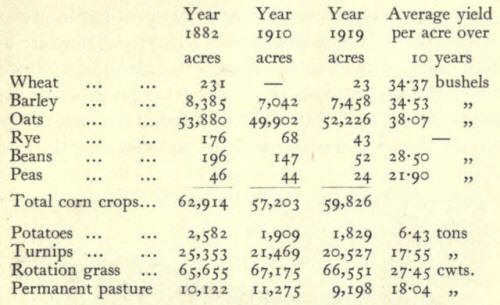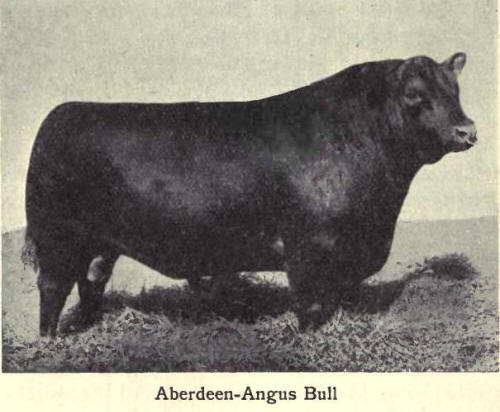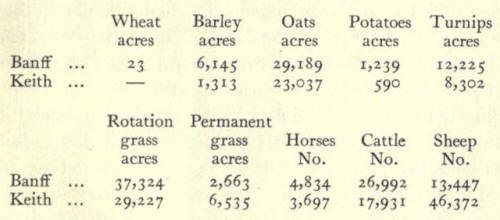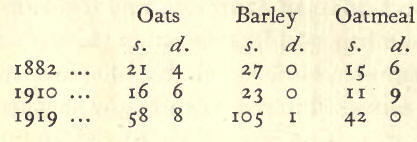|
Agriculture is pursued in a
most enterprising and enlightened manner, and both in arable farming and in
the excellence of farm stock, the county takes a high position. Along the
coast the soil consists mostly of sand and loam, the latter by far the more
predominant, and these in several districts are blended with a proportion of
clay soil. The arable surface along the coast lies in general upon a free
open bottom, while that of the interior is mostly a light black soil on a
hard bottom, retentive of water, hence one of the causes of the lateness of
the crops in these districts.
Up to the middle of the
eighteenth century improvements in agriculture were few. The arable lands
were divided into outfield and infield. To the infield, which consisted of
the acreage nearest to the farm house, the whole manure was regularly
applied; the only crops cultivated on it were oats, bere and peas, and the
land was kept in tillage as long as it would produce two or three returns of
the seed sown. When the field became so reduced and so full of weeds as not
to yield this return, it was allowed to lie in natural pasture for a few
years, after which it was again brought under cultivation and treated in the
same manner. The outfield lands were wasted by a succession of oats after
oats so long as the crops would pay for seed and labour. They were then
allowed to remain in a state of absolute sterility, producing little else
than thistles and other weeds till, after having been rested for some years,
they were again brought under cultivation and a few scanty crops obtained.
There are authenticated cases of fields in Alvah and Boyndie which carried
respectively 12, 14, and rq crops of oats in succession. The system of
farming pursued was clearly described by Alexander Garden of Troup, writing
in 1686. The land as stated, was divided into "in-field" and "outfield." The
in-field was kept "constantly under corne and bear, the husbandman dunging
it every thrie year, and if he reap the fourth corne, he is satisfied." The
outfield was allowed to grow green with weeds and thistles, and after four
or five years of repose was twice ploughed and sown with corn. Three crops
were generally taken in succession and then, or as soon as the soil was too
exhausted to repay seed and labour, reverted to thistle and weeds. That this
system was regarded as completely satisfactory, is shown by the old proverb:
If the land be thrie year oot
and thrie year in,
'Twill keep in good heart till the Deil gaes blin.
If credit for the change is
to be given to one man more than another, it is due to James, sixth Earl of
Findlater and third Earl of Seafield (d. 1770). He was an enthusiastic
agriculturist, and practically transformed the face of his extensive
territories, a sober eulogist writing that to him appertained "the exclusive
merit of introducing into the North of Scotland those improvements in
agriculture and manufactures, and all kinds of useful industry, which in the
space of a few years raised his country from a state of semi-barbarism to a
degree of civilisation equal to that of the most improved districts of the
south." It was he who, about i 754, introduced in the north the system of
alternate husbandry. He took some of his farms into his own possession, set
about cultivating them in the most approved manner then known in England,
under the oversight of experienced men from the south, and in a few years
improved such farms as Craigherbs in the parish of Boyndie and Colleonard in
the parish of Banff as well as the fields about Cullen House in a manner
then unknown in these districts. He further granted to some of the most
intelligent and substantial tenants leases for two 19 years and a lifetime,
under which they became bound to enclose and subdivide a certain portion of
the farm with stone fences or ditch and hedge during the first 19 years, and
in the course of the second 19 years to enclose the remainder, while they
had to sow grass seeds on a certain number of acres within the first five
years of the lease. He was the first also to introduce turnip husbandry and
thus pave the way for the home-feeding of cattle during winter. Other landed
proprietors acted on a similarly enlightened policy. James, Earl of Fife,
granted leases to improving tenants of from 25 to 30 years, with an ample
allowance for building houses and dykes; and Alexander Garden of Troup
followed a similar practice.
By 1812, on the larger farms
where long leases had been granted, turnips were being laid down with
manure, and grass seeds were being sown with bere or oats. A further
improvement was effected when the broad-cast sowing of turnips gave place to
drill husbandry. In course of time the eight or ten owsen plough was
abandoned for an implement of greater tillage power hauled by horses, while
with the improvement of roads the double carts (carts, that is, with a shaft
and a trace horse to one cart) gave place to single-horse carts.
The system of holding land
under lease for a period of years still prevails. In the uplands the arable
area rises from the valley and ascends the hillside till it abuts on the
heather; and in these high-lying places account has to be taken of losses
through stress of weather and by game, so that in some seasons quantities of
reliable seed have to be imported from more favoured districts, all
circumstances that are, as a rule, reflected in the amount of the rental.
Wheat used to be grown to
some extent, but in this northern climate the quality was often indifferent
and the produce variable; and that, together with low prices and the poor
feeding qualities of the straw, has led to its practical disappearance. Oats
of the potato variety are chiefly grown; Sandwich oats, and more recently,
black oats, are also cultivated, while of late years the large American
varieties have been introduced. The standard weight is 42 lbs. per bushel. A
large part of the oat crop is manufactured locally into oat meal, but much
of it goes also to Newcastle and Leith, a considerable part for consumption
in the hunting districts. The barley grown in the county is not often of the
bright and attractive colour that is desired by brewers, but it finds a
large and remunerative market at local malt distilleries. The turnip crop is
vital to the industry of a county that is essentially a stock-rearing and
feeding area. During the long northern winter, cattle kept for breeding
purposes and young stock get little save turnips and oat straw, thriving
magnificently upon such a diet, while cattle that are in course of finishing
have supplies of feeding cake and second qualities of grain. Hay is for the
most part grown only for local needs. Flax, raised. in small quantities in
every quarter of the county a century ago, is now seldom seen.
There are in the county 3418
agricultural holdings of an average size of 46.8 acres. Of that number 2333,
or 68.26, have an area of from 1 to 50 acres; there are 1059 holdings of
between 5o and 300 acres, and 26 farms of over 300 acres.
The area of the county,
excluding water, is 403,053 acres; and in the year 1919 there were under
corn crops and rotation grass 126,377 acres. The following figures show the
cultivation of crops at different periods, and the average yearly yield over
a period of ten years:

The county is very wealthy in
its pure-bred farm-stock. Of the native Aberdeen-Angus breed (indigenous to
the north of Scotland and now found, by its own great beefing merits, in
every agricultural country), Banffshire possesses the most famous collection
in the world—that of Sir George Macpherson Grant, Bart., of Ballindalloch,
one of the oldest herds of the variety and as famous on American ranches, on
the estancias of the Argentine, on the veldt of South Africa and in the New
Zealand bush, as it has for many years been in this country. All the world
over this great collection at the confluence of the Spey and the Aven is
regarded as the fountain-head of the breed. There are other Aberdeen-Angus
herds of great excellence in the county. The "great intruder," the
Shorthorn, has also found a favoured home. Eden and Rettie were among the
earliest seats of the breed in the north of Scotland, and in the case of
this as of the other great cattle breed, many of the local herds are well
known in national showyards and in the foreign trade. The commercial cross
cattle of the county are of a high standard, and in the most discriminating
meat market of the world, that of Smithfield, they are included in the
number of select cattle classed as "Prime Scots," and uniformly bring the
extreme price of the day. On several occasions cattle bred and fed in the
county have won the blue ribbon of the fat stock world—the championship of
the London Smithfield Show. At the Scottish Fat Stock Show and at the show
of the Smithfield Club in 1919, the champion and reserve champion of both
came from Banffshire herds on Speyside, a circumstance unexampled in the
agricultural annals of any county in the Kingdom.

Of late years an increased
amount of attention has been devoted to Clydesdale breeding, and in the
production of strong active geldings for city use, the county enjoys a high
reputation. Sheep, too, are a valuable farming asset. There are some select
flocks of Leicesters and Cheviots, but there are larger numbers of
black-faced and cross-breds, which spend the summer months on the hills and
in the hard weather are wintered in the pastures and surplus turnips of the
low country. The possessions of the county in farm live-stock at different
periods have been:

The difference in the
physical character of the two local government districts in the county is
well illustrated by figures of cultivation and live-stock. In the level and
fertile Banff district there are i 25,645 acres and in the more mountainous
Keith district there are 277,408 acres, while the principal figures of crops
and stock in 1919 were:

The value of the crops grown
in the county in the years mentioned is of interest. In the case of the
principal field produce the fiars prices struck were as follows, barley and
oats being both first quality and the price per imperial quarter, while the
oatmeal is per boll of 140lbs.:

|

